Latest book
reviews of 1 August 2018
Wilhelminalaan 33John Elburg
7261 BP RUURLO
The Netherlands.
Chess Books
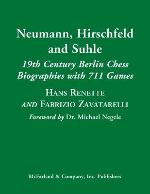
Neumann, Hirschfeld and Suhle
19th Century Berlin Chess Biographies with 711 Games by Hans Renette and Fabrizio Zavatarelli
2018
McFarland & Company,Inc.,Publishers Box 611
Jefferson,North Carolina 28640.
http://www.mcfarlandpub.com
376 pages
Price $75.00
ISBN: 978-1-4766-7379-0
The two authors Hans Renette Belgium and Fabrizio Zavatarelli Italy have not only created wonderful written biographies on the players, Carl Friedrich Berth Suhle,Philipp Martin Hirschfeld and Gustav Richard Ludwig Neumann but above all created an excellent coverage of a unique insight into Berlin chess life from 1830 until 1890.
Many of us are not aware of but the forgotten Suhe,Hirschfeld and Neumann where ranked among the best players of that time.
The story is that at age 6, von Neumann could divide two 8-digit numbers in his head. As an adult, there wasn’t a mathematician in the world who could keep up with him.
Unfortunately severe mental illness forced him to stop playing chess.
But there are also included small chess biographies from the famous and less famous contemporaries of that time.
So as for example the son of the hair dresser Ludwig Bledow Berlin,1795-Berlin 1846,who was in his heyday one of the strongest players of his time,such as La Bourdonnais,Cochrane,young Staunton and Hanstein, but he never took part in any official tournament or match, always playing in the isolated surroundings of Berlin.
That time is was very common to join no tournaments as the well known baron Tassilo van der Lasa who obtained good results against the strongest players of his time.
Hans Renette is responsible for the contribution on Gustav Richard Ludwig Neumann,and Fabrizio Zavatarelli for Carl Friedrich Berth Suhle and Philipp Martin Hirschfeld.
First I would like to invite the player to the following beautiful game,rich in deep combinations: Steinitz,William - Neumann,Gustav Richard [C38]
Paris Congrès International Paris, 01.07.1867
1.e4 e5 2.f4 exf4 3.Nf3 g5 4.Bc4 Bg7 5.d4 d6 6.0-0 h6 7.c3 Nc6 8.Qb3 Qe7 9.Na3 Nf6 10.Bd3 Nh5 11.Bd2 0-0 12.Bc2 a6 13.Qc4 Kh8 14.Rae1 Qd8 15.g3 g4 16.Nh4 f3 17.Qd3 Nf6 18.h3 Ne7 19.Nc4 b5 20.Ne3 h5 21.Neg2 c5 22.Bb1 fxg2 23.Rxf6 Bxf6 24.e5 Ng6 25.exf6 Qxf6 26.dxc5 gxh3 27.c4 Kg8 28.Bc3 bxc4 29.Qd5 Bb7 30.Qxh5 Rfe8 31.Rd1 Ne5 32.cxd6 Rad8 33.Qh7+ Kf8 34.Bf5 a5 35.d7 Re7 36.Bxa5 Rdxd7 37.Bxd7 Nxd7 38.Bb4 Ke8 39.Kh2 g1Q+ 40.Kxg1 Qb6+ 41.Kh2 Qxb4 42.Qc2 Re1 43.Nf5 Rxd1 44.Qxd1 Qxb2+ 45.Kxh3 Qg2+ 46.Kh4 Bd5 47.Qe1+ Be6 48.Ng7+ Ke7 49.Qb4+ Kf6 50.Nh5+ Ke5 51.Qe1+ Kd4 52.Qd1+ Kc5 53.Nf4 Qe4 54.Qh5+ Qf5 55.Nxe6+ fxe6 56.Qe2 Nf6 0-1.
This game is well analysed with the annotations of that time.
Drawing on a range of sources, the authors fill this gap, providing games with both old and new analyses. An introductory chapter on Berlin chess before 1860 and an appendix on Bernhard von Guretzky-Cornitz complete this wonderful made book.
Conclusion: One of the most interesting written chessbooks of this time!

The magic of chess tactics by Dr. Karsten Müller &Claus Dieter Meyer
2017
Russell Enterprises
Inc.Milford,CT USA
190 pages
Price $24.95
ISBN 978-1-941270
A few years ago we had the electronic release of The magic of Chess Tactics and now it is a great pleasure for me to announce this will
printed release of Russell Enterprises.
Tactics is a matter of recognizing tactical patterns, and both authors have managed to compile all the material on attacking techniques and transformations.
Just go throw these challenging positions and you will learn to play and understand the techniques of tactical play as we see in the following game:
1.Nf3 Nc6 2.g3 d5 3.Bg2 Bg4 4.d4 Qd7 5.Ne5 Nxe5 6.dxe5 e6 7.0-0 f6 8.c4 fxe5 9.cxd5 0-0-0 10.f3 Bc5+
11.Kh1 Bh5 12.Bh3 Bf7 13.Nc3 Kb8 14.dxe6 Bxe6 15.Bxe6! A classic diagonal disaster with rich pin themes!
All material in this book is well explained by our famous endgame professor Karsten Müller and companion Claus Dieter Meyer!
Conclusion: One of those highly instructive reads!
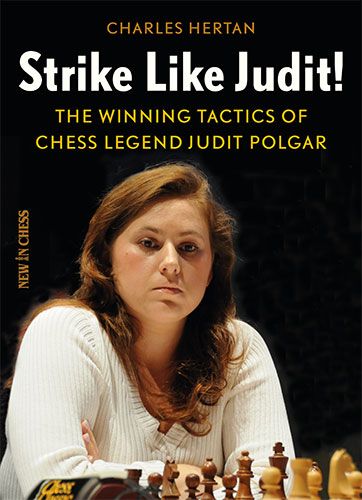
Strike like Judit!: The Winning Tactics of Chess Legend Judit Polgar
by Charles Hertan
2018
New in Chess
http://www.newinchess.com/
255 pages
Price $ 24.95
ISBN: 978-90-569-1770-8
The well known FIDE master and chess trainer Charles Hartan has compiled 109 highly instructive game positions from the legendary Judit Polgar, and where the reader is kindle invited to learn from her killing moves, as for example see her blow on the former world champion Anatoly Karpov:
Polgar,Judit (2722) - Karpov,Anatoly (2693) [C42]
Hoogeveen Essent Crown Hoogeveen (1), 12.10.2003
1.e4 e5 2.Nf3 Nf6 3.Nxe5 d6 4.Nf3 Nxe4 5.d4 d5 6.Bd3 Be7 7.0-0 Nc6 8.c4 Nb4 9.Be2 0-0 10.a3 Nc6 11.cxd5 Qxd5 12.Nc3 Nxc3 13.bxc3 Qd6 14.Rb1 b6 15.Re1 Be6 16.Bd3 Rae8 17.Rb5 Na5 18.Rbe5 Nc6 19.R5e2 Bd7 20.d5 Na5 21.Ne5 Bf6 22.Bf4 Bxe5 23.Bxe5 Qxa3 24.Re3 Qc5 25.Bxh7+ Kxh7 26.Qh5+ 1-0 and Karpov resigned at once! My favourite game in this book is: Shirov,Alexei (2740) - Polgar,Judit (2630) [B54]
Buenos Aires Sicilian Buenos Aires (8), 22.10.1994
1.e4 c5 2.Nf3 e6 3.d4 cxd4 4.Nxd4 Nc6 5.Nc3 d6 6.g4 a6 7.Be3 Nge7 8.Nb3 b5 9.f4 Bb7 10.Qf3 g5 11.fxg5 Ne5 12.Qg2 b4 13.Ne2 h5 14.gxh5 Nf5 15.Bf2 Qxg5 16.Na5 Ne3!! 17.Qg3 Qxg3 18.Nxg3 Nxc2+ 19.Kd1 Nxa1 20.Nxb7 b3 21.axb3 Nxb3 22.Kc2 Nc5 23.Nxc5 dxc5 24.Be1 Nf3 25.Bc3 Nd4+ 26.Kd3 Bd6 27.Bg2 Be5 28.Kc4 Ke7 29.Ra1 Nc6 0-1
In 2005 Judit Polgar became the first woman in chess history to participate in a World Championship finale.
She was also the No. 1 rated woman in the world from January 1989 until the March 2015 rating list, when she was overtaken by the Chinese player Hou Yifan from China.
Conclusion: One of those super reads from New in Chess!
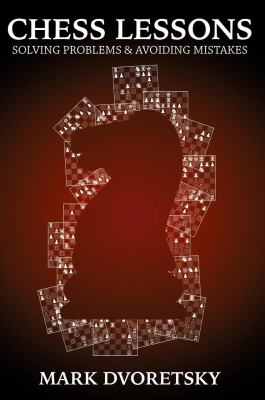
Chess Lessons: Solving Problems & Avoiding Mistakes
by Mark Dvoretsk
2018
Russell Enterprises
Inc.Milford,CT USA
274 pages
Price $24.95
ISBN 978-1-941270813
This penultimate work of the legendary chess trainer Mark Dvoretsky 1947- 2016 holds a analytical master piece taken of Mark Dvoretsky latest manuscript, that saw print by Russel Enterprises and was translated into the English language by Boris Gleyzerov.
The basic aim of Mark Dvoretsky is as he writes in his forward of delving into complex analysis to obtain a most exact and objective pattern of the struggle,to evalute the pros and cons of opponents decisions as accurately as possible.
And where Dvoretsky writes:Some times the result turned out to be a pile of purely computer like variations that made it next impossible to figure out the inner logic of a postion.
In such cases,I would drop variations,leaving only conclusions which resulted from them.
Still,I have included most analyses into the book.
Dvoretsky’s material is divided into the following sections:Part one Lessons from a certain game,Part2 Positional games,Part 3 Discussions in the opening, Part 4 The king in peril,Part5 Under fire,Part 6 Games with questions and Part7 Playing out.
The last two parts of the book are devoted for Mark Dvoretsky so specific way of training: analysis of games in the form of solving a string of consecutive tasks and playing out of certain specially selected positions.
But first some words from Dvoretsky on his contemporaries:
British grandmaster John Nunn is one of world’s best chess authors, and I used games annotated by him in my training sessions more than once.
The reason for that is not so much the high quality of Nunn’s analysis {in our times this is accessible even to less qualified experts-with the help of powerful engines},as his deep understanding of problems that a practical player faces and his ability to convey his ideas to his readers in a convincing manner.
The game Portisch – Timman Hilversum 1984 m{6} gets nearly ten pages of text and the words from Mark Dvoretsky in the introduction text did surprise me:
While annotating this game I used Jan Timman’s comments first published in New in Chess,and than repeated in his book Chess the Adventurous Way.Many of the grandmaster’s conclusions seemed overoptimistic-and at times even obviously erroneous to me.
The late Mark Dvoretsky, the great Russian chess trainer, is probably best known for his outstanding chess books as this great work Chess Lessons Solving Problems and Avoiding Mistakes!
Conclusion: Outstanding trainings manual!
Specially recommend to high ranking chess players or those who like to become one!
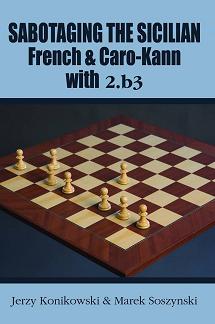
Sabotaging the Sicilian, French & Caro-Kann with 2.b3 by Jerzy Konikowski & Marek Soszynski
2018
Russell Enterprises
Inc.Milford,CT USA
274 pages
Price $14.95
ISBN 978-1-941270837
The well known Jerzy Konikowski and companion Marek Soszynski come with a well thought openings book based on the second move 2.b3 against the Sicilian French and Caro-Kann opening.
After 1.e4 e6.2.b3 d5 3.Bb2 dxe4 4.Nc3 f5 5.f3 they come with the interesting suggestion 5…Bd6 which is much stronger than the older 5…exf3?!
A other improvement is 1.e4 e6 2.b3 d5 3.Bb2 dxe4 4.Nc3 Nf6 5.Qe2 Be7 6.Nxe4!
above the weaker 6.g4?!.
In the Sicilian they suggest after 1.e4 c5 2.b3 g6 3.Bb2 Nf6 4.Qf3!? and after 5….d6
5.Bb5+ Nbd7 6.Bxf6 exf6 7.Qd3 a6 8.Bxd7+ Bxd7 9.Nc3 Be6 10.Nge2 Bg7 11.0-0 0-0 12.Nf4 f5 13.Rae1 it is quite even as we could see in the game, Paichadze,Luka (2452) - Pantsulaia,Levan (2587) [B20]Tbilisi Cup Tbilisi,2010 ½-½.
2.b3 against the Caro-Kann is far less popular than in the French or Sicilian,but Euwe did beat Reti with it: Euwe,Max - Reti,Richard [B10]
Match Reti-Euwe +3-1=0 Amsterdam (3), 01.06.1920
1.e4 c6 2.b3 d5 3.exd5 cxd5 4.Bb2 Nc6 5.g3 e5 6.Bg2 Be6 7.Qe2 Qc7 8.Nf3 f6 9.0-0 Bd6 10.Nc3 a6 11.d4 Nge7 12.dxe5 Bxe5 13.Nxe5 fxe5 14.Rad1 0-0-0 15.Rfe1 h5 16.Na4 e4 17.f3 h4 18.fxe4 hxg3 19.exd5 Bxd5 20.Bxd5 Nxd5 21.Qe6+ Kb8 22.Rxd5 Rde8 23.Qxe8+ Rxe8 24.Rxe8+ Ka7 25.Rdd8 b6 26.Ba3 gxh2+ 27.Kh1 Qf7 28.Re7+ Nxe7 29.Rd7+ Ka8 30.Nxb6+ Kb8 31.Bd6# 1-0
Not so good is a reverse Englund Gambit with 1.e4 d5 2.b3 dxe4 3.Nc3 Nf6 4.Qe2 Nc6!
Conclusion: Surprising good work!
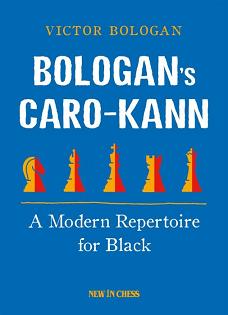
Bologan’s Caro-Kann: A Modern Repertoire for Black
by Victor Bologan
New in Chess
http://www.newinchess.com/
349 pages
Price $ 29.95
ISBN: 978-90-5691-778-4
Grandmaster Viktor Bologan provides the reader with a impressive written move to move repertoire book on the Caro-Kann opening, where the reader often has choices out of two main alternatives.
In the main line Bologan goes for the main line of the Classical System with lines as:
1.e4 c6 2.d4 d5 3.Nc3 dxe4 4.Nxe4 Bf5 5.Ng3 Bg6 6.h4 h6 7.Nf3 Nd7 8.Bd3 Bxd3 9.Qxd3 e6 10.Bd2 Ngf6 11.0-0-0 Be7 12.Ne4 Qc7 13.Nxf6+ Nxf6 14.Ne5 Rd8 15.Bf4 Nd5 16.Bg3 Qa5 17.Qb3 Qb6 18.Qxb6 axb6 19.c4 Nf6 and white is not able to create any danger at all.
In the popular Advance Variation Bologan suggest a set up with 1.e4 c6 2.d4 d5 3.e5 Bf5 4.Nf3 e6 5.Be2 Be7 6.c3 Nd7 7.0-0 c5.
All together there are 59 chapters in this book and that makes it 100 pages thicker as Lars Schandorff’s older and out dated Quality Chess Grandmaster Repertoire book on the Caro-Kann!
A whole chapter is divided to the aggressive 1.e4 c6 2.d4 d5 3.e5 Bf5 4.g4 where the game
Hahn,Eduard - Alekhine,Alexander [B12]
Krakow/Warsaw Krakow/Warsaw (3), 08.10.1941
1.e4 c6 2.d4 d5 3.e5 Bf5 4.g4 Be4 5.f3 Bg6 6.h4 h5 7.e6 Qd6 8.exf7+ Bxf7 9.g5 Qg3+ 10.Ke2 Nd7 11.Be3 Qc7 12.f4 Be6 13.Bh3 Bxh3 14.Rxh3 e6 15.Nf3 Ne7 16.Nbd2 Nf5 17.Nf1 0-0-0 18.Qd3 c5 19.c3 Qb6 20.b3 Be7 21.Bf2 Qc7 22.Ne5 Nxe5 23.fxe5 cxd4 24.cxd4 Kb8 25.Ne3 Nxe3 26.Bxe3 Rc8 27.Bd2 Ba3 28.Rf3 Qb6 29.Rb1 Bb4 30.Rc1 Bxd2 31.Rxc8+ Rxc8 32.Qxd2 Qb5+ 33.Ke1 Qc6 34.g6 a5 35.Rf7 a4 36.Rxg7 axb3 37.axb3 Qb5 38.Rf7 Qxb3 39.g7 Qg3+ 40.Kf1 Qh3+ 41.Kg1 Qg4+ ½-½ still stands.
The move 4.g4 became popular again in 2017,thanks to the efforts of Grigory Oparin and Ian Nepomniachtchi.
A modern analyse from Bologan on the bayonet is 1.e4 c6 2.d4 d5 3.e5 Bf5 4.g4 Be4 5.f3 Bg6 6.e6 fxe6 7.h4 h5 8.Bd3 Bxd3 9.Qxd3 Qd6 10.Qg6+ Kd8 11.g5 e5!
And Bologan explaines:After this move,the fruitlessness of the white queen’s raid becomes clear.
Conclusion: This is a fine and important reference work on the Caro-Kann!
Chess DVD's
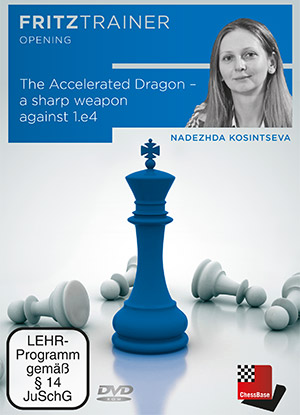
The Accelerated Dragon - a sharp weapon against 1.e4 by Nadezhda Kosintseva
2018
http://www.chessbase.com
E-Mail info@chessbase.com
Price Euro 29.90
Minimum: Dual Core, 2 GB RAM, Windows 7 or 8.1, DirectX11, graphics card with 256 MB RAM, DVD-ROM drive, Windows Media Player 9, ChessBase 14/Fritz 16 or included Reader and internet access for program activation. Recommended: PC Intel i5 (Quadcore), 4 GB RAM, Windows 10, DirectX11, graphics card with 512 MB RAM or more, 100% DirectX10-compatible sound card, Windows Media Player 11, DVD-ROM drive and internet access for program activation.
The well known Nadezhda Anatolyevna Kosintseva (Russian: Надежда Анатольевна Косинцева) comes with a impressive made heavy load coverage of the Sicilian Accelerated Dragon,which runs with the moves 1.e4 c5 2.Nf3 Nc6 3.d4 cxd4 4.Nxd4 g6 where Kosintseva did terrible her best to cover every possible line.
A nice example of this all is:
Maroczy Bind intro [B38]
[GM Nadezhda Kosintseva]
1.e4 c5 2.Nf3 Nc6 3.d4 cxd4 4.Nxd4 g6 5.c4 Bg7 [5...Nf6 6.Nc3 Nxd4 (6...d6 7.Be2 (7.Be3? Ng4) 7...Nxd4 8.Qxd4 Bg7 9.Bg5 a) 9.Be3 0-0 10.Qd2; b) 9.0-0 0-0 10.Qd3 (10.Qe3) ; 9...0-0 10.Qd2 (10.Qe3) ) 7.Qxd4 d6 8.Be3 Bg7 9.f3 0-0 10.Qd2 Be6 11.Rc1 Qa5 12.b3 Rfc8 13.Be2 a6 14.Na4 Qxd2+ 15.Kxd2 Nd7 16.g4 f5 17.exf5 gxf5 18.h3 Rf8 19.f4 Rad8 20.Nc3 d5 21.cxd5 Nf6 22.Bb6 Nxd5 23.Bxd8 Rxd8 24.Nxd5 Bxd5 25.Rh2 Bxb3+ 26.Ke1 Bxa2 27.Bxa6 bxa6 28.Rxa2 Rd4 29.gxf5 Rxf4 30.Ke2 Rxf5 31.Rxa6 Bf6 32.Rg1+ Kf7 33.Rg3 Rb5 34.Re3 Rc5 35.Ra4 Rb5 36.Kf3 Rc5 37.Rb3 Rh5 38.Kg3 Rd5 39.Rab4 Rd1 40.Rb5 Kg6 41.Kf4 Rd4+ 42.Ke3 Ra4 43.Kf3 h5 44.Rb1 Ra3+ 45.R5b3 Ra5 46.Rg1+ Kf7 47.Rf1 Kg6 48.Kg2 Rd5 49.Rf4 Rd2+ 50.Rf2 Rd5 51.Rc2 Kf7 52.Kf3 Rf5+ 53.Ke4 Re5+ 54.Kf4 Ra5 55.Rc4 Kg6 56.Rcb4 Rf5+ 57.Ke4 Re5+ 58.Kf3 Ra5 59.Rb5 Ra4 60.Ke2 Ra2+ 61.Kd3 Ra4 62.Ke3 Kh6 63.R5b4 Ra5 64.Ke4 Kg6 65.Rb5 ½-½ (65) Grachev,B (2658)-Timofeev,A (2555) Sochi 2017] 6.Be3 Nf6 7.Nc3 0-0 8.Be2 d6 9.0-0 Bd7 [9...Nxd4 10.Bxd4 Bd7 11.Qd3 a5 (11...Bc6 12.b4) 12.b3 (12.Rad1 Bc6 13.Rfe1 Nd7 14.Bxg7 Kxg7 15.Qd4+ Kg8 16.Bg4 Ne5 17.Bh3 g5 18.Re3 e6 19.c5 ½-½ (78) Duda,J (2563)-Kuzubov,Y (2642) Yerevan 2014) 12...Bc6 13.a3 (13.Rad1 Nd7 14.Bxg7 Kxg7 15.Qd4+ Kg8 16.Bg4 Nc5 17.e5) 13...Nd7 14.Bxg7 Kxg7 15.b4 Qb6 16.c5 Qc7 17.cxd6 exd6 18.Qd4+ Nf6 19.b5 1-0 (19) Shankland,S (2679)-Fernandez Lopez,J (2142) Baku 2016] 10.Nc2 [10.Rc1 Nxd4 11.Bxd4 Bc6 12.Qd3;
10.Qd2 Nxd4 11.Bxd4 Bc6 0-1 (39) Liepold,S (2188)-Krensing,J (2325) Germany 2017 Maroczy Bishop trading [Kosintseva,Nadezda];
10.f3 Nxd4 11.Bxd4 a5] Line
The user of this DVD will find several dangerous repertoire lines that have seen no print before!
I have two books on the accelerated Dragon or Simagin system in my bookcase but they can not stand-up against this heavy loaded nearly five hour coverage of Nadezhda Anatolyevna Kosintseva!
Included is a heavy loaded database of over 180 entries and where many of them cover excellent annotations.
Conclusion: This is certainly ChessBase on it’s best!
With interactive training including video feedback!
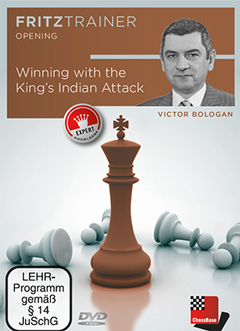
Winning with the King's Indian Attack
by Victor Bologan
2018
http://www.chessbase.com
E-Mail info@chessbase.com
Price Euro 29.90
Minimum: Dual Core, 2 GB RAM, Windows 7 or 8.1, DirectX11, graphics card with 256 MB RAM, DVD-ROM drive, Windows Media Player 9, ChessBase 14/Fritz 16 or included Reader and internet access for program activation. Recommended: PC Intel i5 (Quadcore), 4 GB RAM, Windows 10, DirectX11, graphics card with 512 MB RAM or more, 100% DirectX10-compatible sound card, Windows Media Player 11, DVD-ROM drive and internet access for program activation.
The pronominal Victor Bologan digs with two heavy download files and 25 well filled video files the secrets of the so flexible King’s Indian Attack, that runs with the moves 1.e4 e6 2.d3 d5 3.Nd2 c5 4.Ngf3 Nc6 5.g3 Nf6 6.Bg2 Be7 7.0-0 which was once a favourite of the legendary Bobby Fischer and highly recommended by the famous Mark Dvoretsky.
A fine example of play is: Fischer,Robert James - Geller,Uzi [A08]
Netanya-A Netanya (11), 29.06.1968
1.e4 e6 2.d3 d5 3.Nd2 c5 4.g3 Nf6 5.Bg2 Be7 6.Ngf3 0-0 7.0-0 Nc6 8.Re1 Qc7 9.e5 Nd7 10.Qe2 b5 11.h4 a5 12.Nf1 Nd4 13.Nxd4 cxd4 14.Bf4 Ra6 15.Nh2 Rc6 16.Rac1 Ba6 17.Bxd5 exd5 18.e6 Qd8 19.exd7 Re6 20.Qg4 f5 21.Qh5 Qxd7 22.Nf3 g6 23.Qh6 Bf6 24.Rxe6 Qxe6 25.Be5 Bxe5 26.Re1 f4 27.Rxe5 Qd7 28.h5 fxg3 29.hxg6 gxf2+ 30.Kxf2 hxg6 31.Qxg6+ Qg7 32.Rg5 1-0,a bloodthirsty and illustrative example,Angus Dunnington in his book The Ultimate King’s Indian Attack.
The secret of this all that white plays a King’s Indian with a tempo more!
Included is an extra file of over 50 entries but unfortunately with no extra comments.
Running time is 4 hours and 27 minutes!
Conclusion: Very important reference material on the King’s Indian Attack!
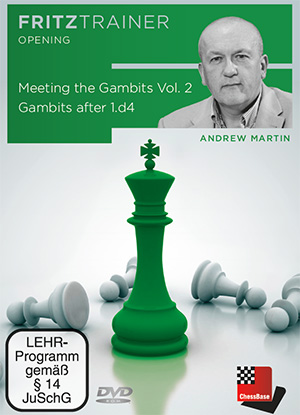
Meeting the Gambits Vol.2 - Gambits after 1.d4
by Andrew Martin
2018
http://www.chessbase.com
E-Mail info@chessbase.com
Price Euro 29.90
Minimum: Dual Core, 2 GB RAM, Windows 7 or 8.1, DirectX11, graphics card with 256 MB RAM, DVD-ROM drive, Windows Media Player 9, ChessBase 14/Fritz 16 or included Reader and internet access for program activation. Recommended: PC Intel i5 (Quadcore), 4 GB RAM, Windows 10, DirectX11, graphics card with 512 MB RAM or more, 100% DirectX10-compatible sound card, Windows Media Player 11, DVD-ROM drive and internet access for program activation.
The famous ChessBase author,IM and chess trainer Andrew Martin explains in a small 5 hours and 49 minutes the secrets of
The Benko Gambit - 1.d4 Nf6 2.c4 c5 3.d5 b5,The Budapest Gambit (including the Fajarowicz Gambit) - 1.d4 Nf6 2.c4 e5,The Albin Counter-Gambit
1.d4 d5 2.c4 e5,The Von Hennig-Schara Gambit - 1.d4 d5 2.c4 e6 3.Nc3 c5 4.cxd5 cxd4 and the good old
Queen’s Gambit 1.d4 d5 2.c4 e6 3.Nc3 Nf6.
All packed in six video sections where in the last one you are invited to do some self tests simple to see if you have understood the patterns of attack!
A fine example of white play is: Mamedyarov,Shakhriyar (2756) - Lux,Gregory (2065) [A51]
Reykjavik op Reykjavik (1), 10.03.2015
1.d4 Nf6 2.c4 e5 3.dxe5 Ne4 4.a3 Nc6 5.Nf3 d6 6.Bf4 g5 7.Be3 g4 8.Nfd2 Ng5 9.exd6 Bxd6 10.Nc3 f5 11.g3 Ne6 12.h3 f4 13.gxf4 Bxf4 14.Bxf4 Nxf4 15.e3 g3 16.fxg3 Qe7 17.gxf4 Qh4+ 18.Ke2 Bg4+ 19.hxg4 Qxh1 20.Nf3 Rd8 21.Nd5 0-0 22.Kf2 Rd6 23.Bd3 Qh6 24.g5 Qg7 25.Qc2 h6 26.Rg1 Kh8 27.gxh6 Qxh6 28.Qc3+ 1-0
Conclusion: Andrew Martin truly explains how to destroy gambits!
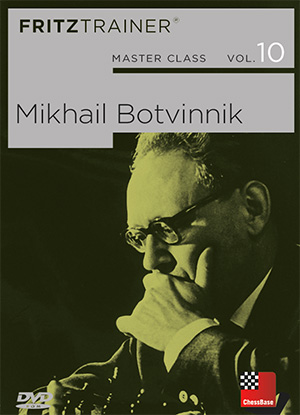
Master Class Vol.10: Mikhail Botvinnik
by Dr. Karsten Müller, Mihail Marin, Oliver Reeh & Yannick Pelletier
2018
http://www.chessbase.com
E-Mail info@chessbase.com
Price Euro 29.90
Minimum: Dual Core, 2 GB RAM, Windows 7 or 8.1, DirectX11, graphics card with 256 MB RAM, DVD-ROM drive, Windows Media Player 9, ChessBase 14/Fritz 16 or included Reader and internet access for program activation. Recommended: PC Intel i5 (Quadcore), 4 GB RAM, Windows 10, DirectX11, graphics card with 512 MB RAM or more, 100% DirectX10-compatible sound card, Windows Media Player 11, DVD-ROM drive and internet access for program activation.
Again a super made master class DVD on the legendary Mikhail Botvinnik 1911-1995 who was one of the greatest players of all time,and a important key figure in the development of chess in the Soviet Union. Also a hardworking chess player with high analytical skills who became later the hero of the Soviet Union!
This impressive made DVD holds interactive tactics tests with video feedback,all Botvinnik games and that are exactly counted 1235 of them,tactic training file with 103 Botvinnik games and 410 trainings questions,Botvinnik Powerbook,biography,endgame file,openings file and more!A fine example of this all is the following game against Vsevolod Rauzer 1908-1941 who died at the war in Leningrad.
Rauzer,Vsevolod - Botvinnik,Mikhail [B74]
URS-ch08 Final Leningrad (Russia) (4), 19.08.1933
[Tarrasch/Botvinnik]
(Quellen: Tarrasch: Tarrasch's Schach-Zeitung 5/33; Botvinnik: Izbrannye Partii 1926-1936, Moskau-Leningrad 1936; Sachmatnoe Tvorcestvo Botvinnika, Moskau 1965; Analiticheskie i kriticheskie raboty 1923-1941, Moskau 1984) 1.e4 c5 2.Nf3 Nc6 3.d4 cxd4 4.Nxd4 Nf6 5.Nc3 d6 6.Be2 [Auf Rat Rauzers spielt man jetzt gewöhnlich 6.Bg5 , um den Zug 6...g6 nicht zuzulassen. Darum sollte Schwarz also, falls er die Drachen-Variante spielen möchte, 2...d6! 3.d4 cxd4 4.Sxd4 Sf6 5.Sc3 g6 spielen. Als diese Partie gespielt wurde, gab es Rauzers Untersuchungen noch nicht. (Botvinnik 1936);
Später schlug Rauzer hier auch den Zug 6.f3! vor, der heutzutage als die beste Erwiderung auf die "Drachen-Variante" gilt. (Botvinnik 1965)] 6...g6 Diese Fortsetzung, die sogenannte Drachen-Variante, galt theoretisch lange Zeit als unbefriedigend für Schwarz. In den letzten Jahren erschien sie aber wieder verstärkt in der Turnierpraxis. (Botvinnik 1936) 7.Be3 Bg7 8.Nb3 "?" Nach dem scheußlichen Springerzuge gleicht sich das Spiel rasch aus, weil Schwarz nun seine um zwei Züge rückständige Entwicklung rasch nachholen kann. (Tarrasch)
Ein unumgänglicher Zug, da Schwarz anderenfalls sein Spiel durch d6-d5 erleichtert. (Botvinnik 1936) 8...Be6 Folgt Beckers Vorschlag (in seiner Monographie "Die Sizilianische Partie"), der diesen Zug für den stärksten hält. (Botvinnik 1936)
Der von vielen als zweckmäßig betrachtete Einschub 8...a5 9.a4 erregt Zweifel, da die Schwäche des Punktes b5 spürbarer ist als diejenige von b4. (Botvinnik 1984) 9.f4 In diesem Moment hat der Zug wenig Wert, jetzt war Fortsetzung der Entwicklung durch die Rochade oder [9.Qd2 angezeigt 9...Ng4 10.Bxg4 Bxg4 11.Bh6 im weiteren Verlauf der Partie stellt sich der Bauernzug als nachteilig heraus. (Tarrasch)] 9...0-0 10.0-0 [Bezüglich des Zuges 10.g4 vergleiche man die Partien Alechin-Botvinnik, Nottingham 1936 und Kan-Botvinnik, Moskau 1936. (Botvinnik 1936)] 10...Na5 "!" Droht, mit dem Springer nach c4 einzudringen. (Tarrasch) [Ein anderer möglicher Plan besteht in dem Manöver 10...Qc8 , womit das Feld g4 unter Kontrolle gebracht wird, mit nachfolgendem 11...Td8. (Botvinnik 1984)] 11.Nxa5 Dies ist freilich das bequemste Auskunftsmittel, entwickelt aber den Gegner. (Tarrasch)
Der Springer drohte, auf c4 eine ausgezeichnete Stellung einzunehmen, freilich durfte er aber nicht abgetauscht werden, womit die Entwicklung des Gegners befördert wird. (Botvinnik 1936) [Besser ging der Springer wieder nach d4 zurück(!) 11.Nd4 , etwa mit der Folge 11...Nc4 12.Nxe6 Nxe3 13.Qd3 fxe6 14.Qxe3 mit befriedigendem Spiel für Weiß. Auch der Rückzug des Springers nach d2 (11.Sd2) zu besserer Deckung des Punktes c4 war dem Abtausch vorzuziehen, denn dann stand der Springer a5 ungünstig. (Tarrasch);
Die Korrektheit des Zuges 10...Sa5 ist von Becker nachgewiesen worden. Die Pointe zeigt sich darin, daß Weiß nach 11.f5 Bc4 12.e5 Bxe2 13.Qxe2 dxe5 14.Rad1 Qc7 15.Nb5 Qc4! keine Figur gewinnt.;
Die anscheinend beste Spielmethode fand an dieser Stelle Judovich. Er spielte 11.Nd4 Bc4 12.Bd3! (in der Partie Judovich-Ragozin aus dem Wettkampf Moskau-Leningrad 1933), worauf es für Schwarz schlecht ist mit 12...Bxd3 fortzusetzen, da Weiß mit 13.cxd3 den Punkt c4 verteidigt. (Botvinnik 1936);
Die anscheinend beste Spielmethode an dieser Stelle fand 1934 R. Spielmann: 11.f5 Bc4 12.Bd3! (Botvinnik 1965)
Aber wie später herausgefunden wurde, kann Schwarz mit ihr durch 12...Bxd3 13.cxd3 d5 14.Nxa5 Qxa5 15.e5 d4 fertig werden. (Botvinnik 1984)] 11...Qxa5 Damit hat Schwarz die Initiative erlangt. es ist merkwürdig, daß in genau derselben fehlerhaften Art das Spiel des Weißen schon sehr oft bis zu diesem Punkte und noch weiter von Meistern behandelt worden ist, die gar nicht gemerkt haben, daß sie auf diese Weise nicht das Geringste aus der Eröffnung geholt haben. (Tarrasch)
Das Eröffnungsstadium ist beendet und anscheinend hat Schwarz Vorteil erlangt. Jedenfalls ist sein weiteres Spiel mit weniger Schwierigkeiten verbunden, als das von Weiß. (Botvinnik 1936) 12.Bf3 Fortsetzung der Entwicklung durch Dd2 verdiente den Vorzug. (Tarrasch)
Das vorherige 12.Dd2 verdiente den Vorzug. (Botvinnik 1936) 12...Bc4 13.Re1 Rfd8 Der Turm soll auf der d-Linie zur Wirkung gebracht werden, entweder nach e7-e5 (fe de) oder auf andere Weise, wie man bald sehen wird. (Tarrasch) 14.Qd2 [Zunächst verbietet sich jetzt der sonst starke Zug 14.Bd4 wegen der Antwort 14...e5 (Tarrasch)] 14...Qc7 In einigen Varianten war der Zug Sd5 von Weiß unangenehm, da er den Abtausch der Damen erzwingen würde. (Botvinnik 1936) [In solchen Stellungen liegt bekanntlich oft ein Überfall auf die ungedeckte schwarze Dame mittels 14...-- 15.Nd5 in der Luft. Hier drohte dies allerdings noch nicht, denn nach 15...Qxd2 16.Nxe7+? (und bei 16.Bxd2 Nxd5 17.exd5 Bxb2 einen Bauern.) 16...Kf8 17.Bxd2 hätte Weiß den Springer verloren. (Tarrasch)] 15.Rac1 Ein stumpfer Zug, statt dessen Df2 geschehen sollte, aus zwei Gründen: erstens ist es meist nicht gut, die Dame in der Linie eines feindlichen Turmes zu lassen, und wenn noch so viele Steine zwischen beiden stehen; und zweitens war der Bauer a7 nicht ganz einfach zu decken. (Tarrasch)
Nach diesem passiven Zug gerät Weiß auf die Bahn ernsthafter Verwicklungen, auf der er sich schnell verirrt. Das Einfachste war 15.Df2, was den Schwarzen durch die Bedrohung von a7 von seinen Plänen ablenkt. (Botvinnik 1936) [15.Qf2 Wie kann Schwarz den angegriffenen Bauern decken? Direkt überhaupt nicht, denn auf a7-a6 gewinnt Lb6 die Qualität und auf b7-b6 folgt der Doppelangriff e4-e5. Aber indirekt läßt sich der Bauer decken, nämlich durch 15...Nd7 Schlägt dann der Läufer den Bauern, 16.Bxa7 , so wird er durch 16...b6 abgesperrt und erobert. Diese Absperrung des Läufers ist ein sehr alltägliches Ereignis, nur ist für gewöhnlich der absperrende Bauer durch einen Bauern gedeckt anstatt durch einen Springer. (Tarrasch)] 15...e5 Hierauf war es natürlich am einfachsten, mit fe de Df2 fortzufahren, was zum Ausgleich führte. Vor allem war damit der sehr gefährliche Läufer g7 ausgeschaltet. Aber dem Gegner durch f4xe5 von dem unangenehmen Sperrstein d6 zu befreien, lag nicht im Interesse des Weißen. Deshalb war es noch stärker, sofort Df2 zu ziehen und auf Sd7 mit f4-f5 den Läufer ebenfalls eingeschränkt zu halten. (Tarrasch)
Hätte Weiß den Gedanken hinter diesem Zug verstanden, so würde er hier einfach mit 16.fxe5 und danach 17.Df2 fortsetzen, womit er sich Ausgleich verschafft haben würde. (Botvinnik 1936) 16.b3 Hierauf folgt eine höchst peinliche Überraschung. (Tarrasch) [Auf 16.Qf2 hätte Schwarz wie in der Partie mit 16...d5 geantwortet, womit er hervorragendes Spiel erreichen würde, z. B.: 17.exd5 (17.fxe5 Nxe4) 17...exf4! 18.Bxa7 Nxd5 19.Bxd5 Bxd5 20.Nxd5 (20.Bb6 Qc4) 20...Rxd5 usw. (Botvinnik 1936)] 16...d5 "!!" Dieser Zug verrät hohe Genialität. Anstatt den angegriffenen Läufer wegzuziehen, stellt Schwarz einen Bauern ein! Ein solcher Zug verspricht für Botwinniks Zukunft alles Mögliche! Die wunderbare und höchst verwickelte Kombination ist in allen Varianten vollkommen korrekt, sonst wäre sie eben nicht genial, sondern innerlich unwahr. (Tarrasch)
"!!" Dieses Opfer ist offenbar in allen Varianten vollkommen korrekt. Jetzt droht d5-d4. (Botvinnik 1936) 17.exd5 [Schlägt Schwarz den Läufer, 17.bxc4 , so hält sich Schwarz durch 17...dxe4 an dem Läufer f3 schadlos. Jetzt und in der Folge zeigt es sich, wie ungünstig die Dame in der Linie des feindlichen Turmes steht. (Tarrasch)] 17...e4 "!" (Tarrasch)
"!" Das war die erste meiner Partien, die durch die Schachpresse in der gesamten Welt lief und solche Analytiker wie Tarrasch und Becker studierten diese Stellung. (Botvinnik 1984)
18.bxc4 Weiß sucht Gegenchancen in der Annahme des Opfers und wählt damit anscheinend den zweckmäßigsten Weg. Dies wird aus den folgenden Varianten deutlich. (Botvinnik 1936) [Schlägt Weiß stattdessen auf e4, so kommt er durch Angriffe auf die Dame in Nachteil: 18.Nxe4 Nxd5 19.bxc4? (oder 19.Kh1 Nxe3 20.Qxe3 Bd4 21.Qd2 Bb2 22.Qb4 Bd5 (oder e6) (Schwarz kann aber auch vorziehen, mit 22...Bxc1 den Turm zu schlagen und den sich nach 23.Nf6+ ergebenden Gegenangriff in den Kauf zu nehmen.([Fritz5: 23.Qc3! f5 (23...Bxf4 24.Nf6+ Kf8 25.Nd5 Be5 26.Rxe5 Qd6 27.bxc4+-; 23...Bd2 24.Nxd2 Rxd2 25.Qxd2 Be6±) 24.Nf6+ Kf7 25.Bd5+ Rxd5 26.Nxd5 Bb2 27.Qxc4 Qxc4 28.bxc4² ]) ) 23.Rb1 Qxc2 und Schwarz steht gut genug) 19...Nxe3 20.Qxe3 und die Dame ist verloren; 20...Bd4 ;
Oder 18.Bxe4 Nxe4 19.Nxe4 Bxd5 20.Nc5 (nach g3 darf der Springer nicht, 20.Ng3 , wegen des Qualitätsverlustes durch 20...Bc3; oder 20.Qd3 f5 nebst Lg2:) 20...Bxb3 Immer kommt Schwarz gut auf seine Kosten. (Tarrasch);
I. 18.Bxe4 Nxe4 19.Nxe4 Bxd5 20.Qd3 (Nicht 20.Ng3 wegen 20...Bc3) 20...Qc6 21.Bf2 Re8 nebst Lxg2.;
II. 18.Nxe4 Nxd5 19.Kh1 Nxe3 20.Qxe3 Bd4 21.Qd2! Diese Stellung ist nach dem Qualitätsgewinn durch Lb2 äußerst kompliziert und für Schwarz angesichts der geschwächten Diagonale a1-h8 gefährlich. Aber wie Becker nachwies, wird der Angriff von Weiß zurückgeschlagen, z.B. : 21...Bb2 (21...Be6 22.c4 Be5 23.Qc2 Bxf4 ist ebenfalls vorteilhaft für Schwarz.) 22.Qb4 Bxc1 (Man kann auch lt. Tarrasch mit 22...Bd5 23.Rb1 Qxc2 fortsetzen.) 23.Nf6+! Kh8! 24.Qc3 Bd2 25.Qb2 Be6! 26.Nd5+ (26.c4 Qa5) 26...Bc3 27.Nxc3 Kg8 28.Ne4 Qxf4 29.Nf6+ Kf8 mit Vorteil für Schwarz. (Botvinnik 1936)] 18...exf3 Nun bedarf der Bauer c4 der Deckung. (Tarrasch) 19.c5 Qa5 Damit droht Schwarz den Damenbauern zu schlagen. Zugleich ist aber auch der Springer c3 durch den Angriff Sg4 gefährdet. (Tarrasch) 20.Red1 Hierauf wird der Angriff Sg4 nebst f3-f2+ zu stark. (Tarrasch)
"?" Dieser Zug führt forciert zur vernichtenden Niederlage. (Botvinnik 1936) [20.d6 Ng4 21.Ne4 (21.Bd4? f2+! und Schwarz gewinnt Turm oder Springer, der auf verlorenem Posten stehende Bauer f3 spielt, solange er nicht geschlagen ist, eine sehr wichtige Rolle;) 21...Qxd2 22.Bxd2 (bei 22.Nxd2 geht durch Tausch auf e3, 22...Nxe3 23.Rxe3 nebst 23...Bd4 die Qualität verloren) 22...f2+ 23.Nxf2 Bd4 und auch jetzt erobert Schwarz die Qualität.;
Deshalb wäre es noch das Beste gewesen, den gefährlichen Bauern f3 zu schlagen, nach 20.gxf3 Nxd5 21.Nxd5 Qxd2 22.Bxd2 Rxd5 (hätte der Springer zuvor auf e7 Schach gegeben, so würde der Turm den Läufer schlagen) 23.Be3 hat sich Weiß in ein Endspiel gerettet, in dem er zwar ungünstig steht, weil alle seine Bauern vereinzelt sind, in dem er aber doch zunächst einen Bauern mehr hat. (Tarrasch);
Schlecht ist natürlich 20.d6 (Es drohte Sxd5) 20...Ng4 21.Ne4 Qxd2 22.Bxd2 (22.Nxd2 Nxe3 und Ld4) 22...f2+ 23.Nxf2 Bd4 mit Vorteil für Schwarz.;
Auch nach 20.gxf3 Nxd5 21.Nxd5 Qxd2 22.Bxd2 Rxd5 hat Weiß, dank seiner schwachen Bauern, ein wenig angenehmes Endspiel erlangt.;
Die richtige Fortsetzung war 20.Qd3! , z. B.: 20...Ng4 21.Ne4 f5 22.Ng5 f2+ 23.Bxf2 Nxf2 24.Kxf2 Qxc5+ 25.Kg3 Qxd5 (25...Rxd5 26.Qb3) 26.Qxd5+ Rxd5 und die Chancen beider Seiten in diesem Endspiel sind ungefähr gleich. (Botvinnik 1936);
Richtig war 20.Qd3 Hierauf darf der Springer das Feld f6, von dem aus er das Zentrum kontrolliert, nicht verlassen. Schwarz sollte mit 20...b6! antworten. (Als N.Grigoriev, der Vorsitzende der Jury für die Vergebung der Schönheitspreise, diese Partie prüfte, beschäftigte ihn folgende Variante am meisten: 20...Ng4 21.Ne4 f5 22.Ng5 f2+ 23.Bxf2 Nxf2 24.Kxf2 Qxc5+ 25.Kg3 Rxd5 26.Qb3 Bei der Analyse wurde angenommen, daß Schwarz das Endspiel nach 25...Dxd5 26.Dxd5 Txd5 remisieren kann. Wie mir viele Jaher später allerdings A. Tolush mitteilte, gewinnt Weiß, anstelle von 26.Dxd5, elementar mit 26.Te8+. N. Grigoriev erwies sich also als durchdringend. Nach 20.Dd3 Sg4 21.Se4 steht Schwarz schlecht.) Sowohl nach 21.cxb6 axb6 , als auch nach 21.gxf3 axb6 zerschlägt Schwarz das Zentrum und hat trotz seines Minusbauern angesichts der zahlreichen Schwächen im Lager des Gegners mindestens gleiches Spiel. (Botvinnik 1965)] 20...Ng4 "!" (Botvinnik 1936) 21.Bd4 Wie das in solch kombinationsreichen Stellungen zu gehen pflegt, wählt der Verteidiger von zwei Übeln das größere. (Tarrasch) [Auf 21.Ne4! hätte Schwarz die Damen tauschen und sich mit Rückgewinn des Bauern bei überlegenem Endspiel begnügen müssen: 21...Qxd2 22.Bxd2 Bd4+ 23.Kh1! fxg2+ 24.Kxg2 Rxd5 usw. (Tarrasch);
Den Vorzug verdiente trotz allem 21.Ne4 , wenn auch in diesem Falle nach 21...Qxd2 22.Bxd2 Bd4+ 23.Kh1 fxg2+ 24.Kxg2 Rxd5 Schwarz im entstehenden Endspiel alle Chancen auf den Sieg besitzt. (Botvinnik 1936)] Jetzt hingegen folgt ein Mattangriff mit ganz geringen Kräften, nämlich mit dem Springer, dem verschmähten Bauern und - der Dame, die Botwinnik mit der Geschicklichkeit eines Taschenspielers vom äußersten Damenflügel nach dem äußersten Königsflügel hinüberzaubert. (Tarrasch)
Jetzt aber folgt ein unerwarteter Mattangriff mittels Dame und Springer, bei dem die Dame die Hauptrolle spielt, die sich mit drei forcierenden Zügen vom Damen- auf den Königsflügel hinüberwirft. (Botvinnik 1936) 21...f2+ "!" (Tarrasch) 22.Kf1 [Auf 22.Kh1? erobert Schwarz durch 22...Rxd5! 23.Nxd5 f1Q+! die Dame. (Tarrasch);
Nach 22.Kh1 konnte 22...Rxd5! 23.Nxd5 f1Q+! folgen, wonach Weiß die Dame verliert. (Botvinnik 1936)] 22...Qa6+ 23.Qe2 [23.Qd3 wäre fehlerhaft, denn Schwarz würde den Läufer schlagen, 23...Bxd4 , und nach 24.Qxa6 mit 24...Nxh2+ 25.Ke2 f1Q+ 26.Rxf1 bxa6 eine Figur mehr behalten.;
Auf 23.Ne2 wäre der Angriff mit 23...Rxd5 gefährlich. 24.c3 genügt dann nicht wegen (auf 24.c4 Bxd4! 25.Nxd4! geht der Angriff auf den gefesselten Springer mit (auf 25.cxd5? ist das entzückende Matt durch 25...Nxh2# sehr bemerkenswert) 25...Rad8 26.Qc3 R5d7! weiter.(Fritz5: 26...Rxd4! 27.Rxd4 Rxd4 28.Qxd4 (28.h3 Rxc4-+) 28...Qxa2 29.Qd8+ (29.g3 Nxh2+ 30.Kg2 f1Q#) 29...Kg7 30.Qd4+ Kh6 31.Qg7+ Kxg7 32.Rc2 Qb1+ 33.Ke2 f1Q+ 34.Kd2 Qbe1#) ) 24...Re8 mit der Drohung, durch Se3+ zu gewinnen. (Tarrasch);
Noch schlechter sind andere Verteidigungen: 23.Se2 Lxd5 oder 23.Qd3 Bxd4 24.Qxa6 Ne3+ 25.Ke2 f1Q+ 26.Rxf1 bxa6 und Weiß verbleibt mit einer Figur weniger. (Botvinnik 1936)] 23...Bxd4 24.Rxd4 "!" (Tarrasch) 24...Qf6 "!" (Tarrasch)
"!" Die Überführung der Dame bringt Schwarz materielles Übergewicht. (Botvinnik 1984) 25.Rcd1 [Oder 25.Qd3 Re8 26.Re4 (Falls aber 26.g3 , so 26...Re3 27.Qd2 Rae8) 26...Rxe4 27.Nxe4 Qxf4 mit der Drohung Sxh2+. (Botvinnik 1936)] 25...Qh4 Nun ist der Mattangriff da. Vor allem droht Matt auf h2. 26.Qd3 Re8 "!" (Tarrasch) 27.Re4 f5 "!" (Tarrasch) 28.Re6 "!" (Tarrasch) 28...Nxh2+ Schade, daß sich der russische Jungmeister den adaequaten Schluß der bisher von ihm so schön gespielten Partie entgehen läßt und sich mit einem "ordinären Siege" begnügt, wo er Matt oder Damengewinn oder Ähnliches erzielen konnte! - Ein kleiner Schönheitsfehler bei dieser sonst von dem jungen Meister ganz hervorragend gespielten Partie. (Tarrasch) [28...Rad8! Auf den plausiblen Gegenzug 29.Qb5 folgt (Auf 29.Qg3 tauscht Schwarz die Damen und den Turm e6 und gewinnt dann durch Sg4-e3 den Turm. [Fritz5: 29...Qxg3 30.Rxe8+! Rxe8 31.hxg3 Ne3+ 32.Kxf2 Nxd1+ 33.Nxd1 Rc8µ ]; Ähnlich kommt es bei 29.Qh3 Nxh2+! 30.Ke2 Qxh3 31.gxh3 Rxe6+ 32.dxe6 Rxd1 und der Bauer wird zur Dame, wenn ihn Weiß nicht schlägt.) 29...Rxe6 30.dxe6 Rxd1+ 31.Nxd1 Nxh2+ 32.Ke2 f1Q+ und Schwarz gewinnt in einem Zuge zwei Damen, ein höchst seltenes Naturschauspiel! (Tarrasch);
Schwarz konnte beliebig gewinnen. Einen interessanten Weg zeigte Tarrasch: 28...Rad8! 29.Qb5 (oder 29.Qg3 Qxg3 30.hxg3 Rxe6 31.dxe6 Ne3+) 29...Rxe6 30.dxe6 Rxd1+ 31.Nxd1 Nxh2+ 32.Ke2 f1Q+ usw. (Botvinnik 1936)] 29.Ke2 Qxf4 [29...Qxf4 und Weiß gab auf, denn er muß mit 30.Rf1 die Qualität einstellen und nach 30...Nxf1 31.Kxf1 Rxe6 32.dxe6 Qe5 33.Kxf2! Qxe6 ist das Spiel für ihn ganz aussichtslos. Die Partie erhielt den Schönheitspreis des Turniers. (Tarrasch);
29...Qxf4 Weiß gab auf, da er bei hoffnungloser Stellung die Qualität verliert: 30.Rf1 Nxf1 31.Kxf1 Rxe6 32.dxe6 Qe5 Der Partie wurde der erste Schönheitspreis zuerkannt. (Botvinnik 1936)] 0-1
Conclusion: This is super material!
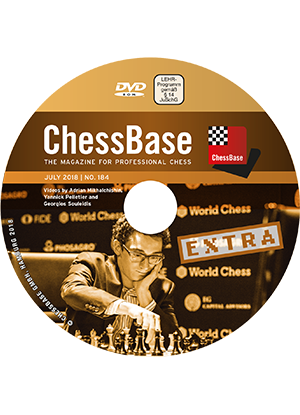
ChessBase Magazine extra issue 184
July 2018
Videos by Adrian Mikhalchishin, Yannick Pelletier and Georgios Souleidis
ChessBase
http://www.chessbase.com
E-Mail info@chessbase.com
ISSN 1432-8992
Euro 12.99
System requirements:
Minimum: Pentium III 1 GHz, 1 GB RAM, Windows Vista, XP (Service Pack 3), DirectX9 graphic card with 256 MB RAM, DVD-ROM drive, Windows Media Player 9, ChessBase 12/Fritz 13 or included Reader and internet connection for program activation. Recommended: PC Intel Core i7, 2.8 GHz, 4 GB RAM, Windows 8.1 or Windows 10, DirectX10 graphic card (or compatible) with 512 MB RAM or better, 100% DirectX10 compatible sound card, Windows Media Player 11, DVD-ROM drive and internet connection for program activation.
This latest ChessBase Magazine comes besides the smashing video files from Adrian Mikhalchishin, Yannick Pelletier and Georgios Souleidis with a impressive amount of,35.855 games all played between April and June of this year!
A fine example of Bobby Fischers favourite Spanish Exchange goes to
Mattsson,Michael (2020) - Sorensen,Hampus (2176) [C68]
Deltalift op Tylosand (7), 12.05.2018
1.e4 e5 2.Nf3 Nc6 3.Bb5 a6 4.Bxc6 dxc6 5.0-0 Bg4 6.h3 h5 7.d3 Qf6 8.Nbd2 Ne7 9.Re1 Ng6 10.c3 Nf4 11.d4 Bd6 12.Nc4 Nxh3+ 13.Kf1 Bxf3 14.Qxf3 Qxf3 15.gxf3 f6 16.Kg2 Nf4+ 17.Bxf4 exf4 18.e5 fxe5 19.dxe5 Be7 20.Rad1 Rd8 21.Na5 Kf7 22.b3 Ke6 23.Nxb7 Rxd1 24.Rxd1 g5 25.Na5 c5 26.Nc6 Rh7 27.c4 g4 28.Nxe7 Rxe7 29.Rh1 Rh7 30.fxg4 h4 31.f3 Rd7 32.Rxh4 Rd2+ 33.Kf1 Rxa2 34.Rh5 Ra3 35.Rf5 Rxb3 36.Rxf4 Kxe5 37.Rf5+ Kd4 38.g5 Rb8 39.g6 Rg8 40.Rf6 Kxc4 41.Rxa6 Kd5 42.Kf2 c6 43.Ke3 Rxg6 44.f4 Rg3+ 45.Kf2 Rg8 46.Ke3 Re8+ 47.Kd2 Re4 48.Kc3 Rxf4 49.Ra8 Rf3+ 50.Kc2 Kd4 51.Rd8+ Kc4 52.Rh8 Rf2+ 53.Kc1 Kb4 54.Rh6 Kb5 55.Rh5 Rf6 56.Kc2 Kb4 57.Rh2 c4 58.Rg2 c5 59.Rh2 Ra6 60.Rh8 Ra2+ 61.Kb1 Rg2 62.Kc1 Kb3 63.Rb8+ Kc3 64.Kd1 Rg1+ 65.Ke2 Kc2 66.Rc8 Rg5 67.Re8 c3 68.Ke1 Kc1 69.Ke2 c2 70.Rh8 Kb2 0-1.
The move 5….Bg4 was described by Fischer as black’s most ambitious continuation.
6…h5 was already mentioned by Alapin and Em Lasker used to win such positions for white after 6…Bxf3.
Conclusion: This is must have material!